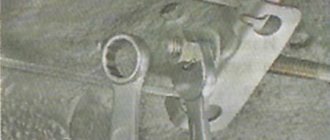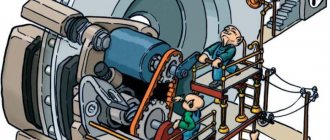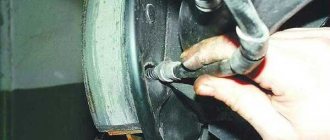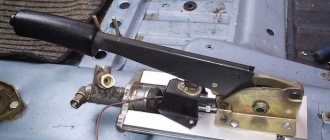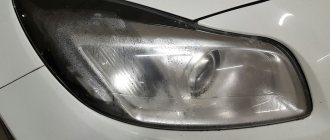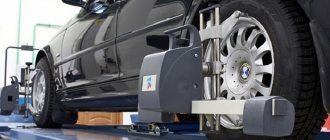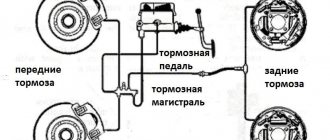09.07.2019
| (No votes) |
Issues discussed in the material:
- How does the parking brake work?
- When is it necessary to adjust the parking brake drive?
- How to understand when it's time to adjust the parking brake drive
- How to adjust the parking brake actuator
Incorrect tension of the handbrake cable entails several problems with the technical condition of the car. As a result, the parking brake will not hold the car motionless, the brake mechanism may overheat, and increased wear of the pads, drums or discs will be observed. You will learn how to adjust the parking brake drive in our article.
Adjusting the parking brake yourself
Before adjusting the handbrake on the Gazelle, lift the rear of the car and place it on supports. After this, remove the wheels to gain access to the brake mechanism. And you should also know that adjustment procedures are carried out with the lever set to the non-working position (lowered all the way).
Monitor the tension of the cable - this is important for your safety
To work, you will need a 17" wrench, two 22" wrenches, a "9" tubular wrench and a flat blade screwdriver. Having prepared the necessary set of tools, proceed to adjust the hand brake in accordance with the following list of actions:
- So, first you need to get to the brake mechanism - to do this, use a screwdriver and remove the upper and lower plastic plugs on the brake shield.
- Next, using a key set to “17”, loosen the eccentric nut two turns (no more) and, sliding the pads, unlock the brake drum. To do this, use a tubular wrench to rotate the eccentric bolt in the opposite direction. If the pads lightly touch the drum, this is acceptable. You can control the entire process through special inspection windows, which are located at the bottom of the brake mechanism flap.
- After this, the eccentric nut must be tightened to a torque of 2.4–3.5 kgf/m. If you do not have a torque wrench on hand, tighten by hand with a reasonable amount of force. In this case, rotation of the eccentric itself is unacceptable.
- At this point, the first stage of adjusting the handbrake on the Gazelle car is completed, so install the plugs in place and do the same on the second wheel.
Now it is necessary to install the cable equalizer in a perpendicular position relative to the axis of the vehicle. This is achieved by loosening the cable fastening nuts. By moving the nuts along the threads, you will install the equalizer in the desired position, while eliminating the play between it and the cable tips. After this, the locknuts must be tightened.
With the completion of the described procedure, the process of adjusting the parking brake is not yet completed, since it is necessary to adjust the tension of the central cable. To begin, lift the handbrake lever one click and, by rotating the adjusting nut at the point where the rear end of the cable is attached to the equalizer (after releasing the lock nut), tighten the tension until the wheels begin to slow down slightly. After this, lower the handbrake lever all the way down and turn each rear wheel by hand. A properly adjusted handbrake should not interfere with rotation. In addition, when setting the vehicle to the parking brake, the lever travel should be 15 clicks of the ratchet mechanism.
From this guide you learned how to tighten the handbrake on a Gazelle without outside help. But sometimes, after a correctly performed adjustment, it is not possible to obtain the expected result due to critical wear or stretching of the cables. In this case, the handbrake cable will have to be replaced, which will be discussed below.
Frequent causes of breakdowns
As a rule, the answer to the question of why the handbrake does not work lies in the most banal things. There are 4 main parking brake faults.
- An incorrectly adjusted bolt that needs to be loosened or tightened.
- Braided cable wedge. In this case, the handbrake breaks down due to moisture getting inside, which leads to corrosion.
- Broken cables running from the bar to the wheels. This element is easy to replace.
- Cable souring. This happens if you do not use the parking brake for a long time.
In addition, the reason why the handbrake breaks sometimes lies in the condition of the brake pads. They can wear out, which is why a characteristic grinding noise is heard when the car stops. In this case, it is necessary to replace worn parts, which, as a rule, fail on the right and left wheels at the same time. Incorrect use of the handbrake itself can also lead to this. It must be completely lowered while driving.
Another reason why the handbrake does not work well is the appearance of deposits on the brake pads. This happens rarely, most often after driving around puddles. Ice, salts and chemicals can be removed by lightly pressing the brakes while driving the vehicle for short distances. In addition, the linings may simply be oily due to a leak in the oil seal or working cylinder. In this case, you must first eliminate the fault in the leaking element, and then completely replace the pads or clean them.
How to replace handbrake cables
If adjusting the Gazelle hand brake turned out to be insufficiently effective or did not lead to anything at all, therefore, you will have to change the brake pad drive cables. In addition to the critical stretch of the cable, it should be changed if damage is detected during an external inspection. And also an indicator for replacement is corrosion and jamming of the cable in the protective sheath.
In order to successfully complete the task, prepare two “22” wrenches, a “12” socket and pliers. We, in turn, will tell you how to change the handbrake cable on a Gazelle:
- Lift the rear of the car to remove the rear wheels and brake drums and shoes.
- Using a socket on “12”, unscrew the two bolts that secure the protective shell to the brake mechanism.
- After removing the socket cable from the brake shield, you need to move to the cable equalizer and use “22” keys to loosen the lock nut and the adjusting nut.
- Next, you should completely unscrew the outer nut, which will allow you to remove the cable from the bracket slot;
- After this, unsplit the equalizer axle using pliers, then remove the washer and remove the axle.
- Now you need to release the equalizer to remove the drive cable from it.
The second cable is dismantled in the same way. As for installing new parts, you can also use these instructions for this, but in reverse order. After completing the replacement, be sure to adjust the parking brake according to the instructions given in the first part of the article.
How to tighten the handbrake
What happens if you overfill oil: terrible consequences
- brake pads were changed;
- brake discs or drums were changed;
- brake pads were adjusted;
- the cable was repaired;
- the handbrake cable was changed;
- an adjusting unit was installed;
- the lever stroke has increased;
- diagnostics showed a malfunction.
Anyone can adjust a mechanical parking brake. This is much easier than doing a wheel alignment yourself, and is also noticeably easier compared to adjusting the low beam headlights on a car.
VAZ 2110: adjusting the handbrake yourself
Parking brake VAZ 2110
The principle of operation of such an element of the VAZ 2110 car as the hand (also known as parking) brake is quite simple. A special cable is used as a mechanical drive for the device. By pulling the handbrake handle, the driver simultaneously provides tension on the cable, which occurs evenly on the brake pads of each wheel. If the parking brake is faulty, you should carry out work such as VAZ 2110 adjusting the handbrake, or repair it by replacing the cable. It is noteworthy that it is easy and simple on the VAZ 2110 to both tighten the handbrake and replace it. If the handbrake malfunctions, the driver runs the risk that the car will move on its own or, conversely, will not be able to continue driving after stopping on an uphill slope. That is why you will have to adjust the handbrake in any case - and this can be done without necessarily going to a car service center. An experienced car enthusiast is able to adjust the parking handbrake of a domestic car on his own.
Life situations
Above are the simplest situations in which you need to use the handbrake.
In addition, it is actively used for sharp turns of 180 degrees. In feature films, you can often see such a trick, the so-called police turn.
In this case, the parking brake affects only the rear wheels, which means it bears the main load.
But this is rare in everyday life, but if the river transport is not working properly, then when moving up or down, a stalemate may arise.
For example, you are standing on a hill, and there is a traffic jam ahead. Definitely, it will be more convenient for you to move off with the handbrake, so as not to crash into the rear of a standing car or burn out the clutch.
Where to start replacing
Replacing the handbrake of a VAZ 2110
First of all, replacing the cable begins with the following operations:
- lowering the handbrake lever all the way down;
- removing the brake disc of the wheel on which the replacement is being made;
- removing the muffler from the suspension cushions, and the resonator from the rear suspension;
- lowering the exhaust system;
- unscrewing the locknut and adjusting nut;
- removing the equalizer from the rod.
- remove the end of the cable being replaced from the equalizer;
- remove the tip of its shell from the bracket located on the car body;
- bend the cable fastening brackets;
- remove the rear brake pad and disconnect the cable end from the lever;
- loosen the nut that secures the cable holder to the rear axle;
- remove the cable first from the holder, then from the bracket, and finally from the brake cleat.
The work ends with the new cable being installed in place in the reverse order to its removal. In this case, it is worth paying attention to the location of the cables in the bracket - it should be crosswise. After installing the part, be sure to adjust the handbrake. Now, knowing how to adjust the handbrake of his car and replace its cable with his own hands, the car enthusiast can avoid contacting a service station, and thus save his money, since the cost of repairs is not low. If instructions for performing all this work are not enough, it is quite easy to find on the Internet both photos and videos showing these processes in great detail.
Transporting a boat: methods of transporting PVC boats, examples
- brake pads were changed;
- brake discs or drums were changed;
- brake pads were adjusted;
- the cable was repaired;
- the handbrake cable was changed;
- an adjusting unit was installed;
- the lever stroke has increased;
- diagnostics showed a malfunction.
Anyone can adjust a mechanical parking brake. This is much easier than doing a wheel alignment yourself, and is also noticeably easier compared to adjusting the low beam headlights on a car.
Parking brake screw-nut
Such parking brake mechanisms are used in a number of foreign cars. Below is the design and operating principle of the parking brake used on Volvo cars.
When the parking (hand) brake lever is lifted, the cable moves relative to the braid resting on the bracket 9 and, using the lever 8, turns the shaft 7 around the axis, at the other end of which there is a plate 6 with three conical sockets of variable depth. Each socket contains a ball 11. Together with the ring 10, these parts form a mechanism that, when rotated, causes the shaft 7 to move in the axial direction. The conical sockets are designed in such a way that the initially large axial movement relative to the rotational movement becomes small, thereby increasing the transmitted force. The axial movement of the shaft 7 is transmitted to the head of the screw 5, which, compressing the spring 12, through the nut 4 transmits force to the piston 3 mounted in the floating bracket 13, and together with the bracket, acting through the brake pads 2, clamps the brake disc 1.
The effect of self-regulation of the parking brake occurs due to the fact that as the “brake pads - brake disc” pair wears out, an increased gap appears and, without encountering resistance, shaft 7 turns screw 5 relative to nut 4, which leads to a decrease in the gap between the brake pads and the disc. The screw-nut pair (items 5 and 4) has play in the threaded connection, which allows the brake mechanism to release the brake disc when the parking brake is not applied.
Rice. Parking brake mechanism: 1 – brake disc; 2 – brake pads; 3 – piston; 4 – nut; 5 – screw; 6 – plate; 7 – shaft; 8 – lever; 9 – bracket; 10 – ring; 11 – ball; 12 spring; 13 – floating bracket
The parking brake is usually driven through a cable by pulling it by hand from the lever handle, but some cars may have a foot pedal control of the parking brake. An example is the Volkswagen Phaeton.
The pedal control cable drive consists of a pedal, a drum, braking and release cables, and a loop spring.
The force applied to the pedal is transmitted by a cable to an equalizer located under the bottom of the car. The equalizer distributes the drive force between two cables that operate the rear brakes.
Rice. Drum-type cable parking brake drive: 1 – parking brake pedal; 2 – drum; 3 – loop spring; 4 – fastening of the cable end; 5 – plastic spring; 6 – brake cable; 7 – brake release cable; a – inhibition; b - disinhibition
When you press the brake pedal, the loop spring is pressed against the drum, increasing the frictional forces against it and counteracting the movement of the pedal in the opposite direction when the brake is tightened. The result is virtually stepless and silent pedal locking. Pressing the brake pedal causes the drum to rotate and the brake cable to tighten.
Handbrake diagram for VAZ-2112
For clarity, here is a diagram of a hand brake
1 - button that fixes the handbrake lever; 2 — hand brake lever; 3 — protective cover; 4 — handbrake rod; 5 — cable equalizer; 6 — adjusting nut; 7 - lock nut; 8 - cable; 9 — protective sheath of the cable.
In this scheme we need element number 6. It is he, and only him!
What is required for adjustment?
In order to adjust the handbrake you need a platform or lift. If there are no such devices, then you can simply hang the rear wheels on the “goats”. They can be installed under the car using a jack. It’s also worth taking two “13” keys and pliers.
- The car is installed on an overpass or “goats”.
The lever position is set to the lowest possible position.
We put the handbrake at the very bottom. Do not pay attention to the scuffs of the console; we conducted an experiment with non-standard armrests. The iron fastenings of the armrest are visible. The photo shows the editorial car
Use a wrench to loosen the locknut.
- The second wrench holds the adjusting nut.
- The adjusting nut should be tightened until the cable is tensioned. It must be remembered that the rod should be held with pliers when tensioning the cable.
- After this, you should make sure that the full stroke of the handbrake lever is no more than 4 and no less than 2 clicks.
- When the stroke check is completed, the locknut is tightened. The adjustment is held with another key.
- If necessary, change the mechanism to a new one.
- After releasing the adjusted lever down, you should spin the rear wheels. When the lever is in its lowest position, the wheels should spin freely.
Tighten the adjusting nut
Everything is rusty, we changed the adjustment mechanism
If you cannot tighten the cable, then it should be replaced with a new one.
Adjusting the handbrake after tensioning
After adjusting the brakes, you need to check them again. To do this, the car should be placed on a road with a slope of at least 23%. The car should be in neutral gear in this area and with the handbrake pulled up. If the handbrake brakes hold the car in this area, then the handbrake is adjusted correctly.
What to do when adjustment does not work
There are also cases when the above actions are not enough to adjust the handbrake. This can happen, for example, when the handbrake cable is broken. This happens on the VAZ-2112, although rarely. In such situations, the cable must be replaced. The cable also needs to be replaced when:
- The tips are loose.
- The cable itself begins to stretch, which will lead to its breakage during operation.
HAIKU! The old cable is very worn out! For comparison, old and new handbrake cables
Physical wear (scuffs and cracks) of the handbrake cables.
Heavy wear on the handbrake cable
This replacement procedure does not require contacting a service station. Although this will require some time and skills from the driver, such work can be done independently.
It should also be remembered that when replacing the cable, certain conditions must be observed. To do this, the driver will need an assistant who will pull the cable.
Why do you tighten the handbrake?
The cable acts here as a drive. If the driver pulls the handbrake lever, then at the same time he uses the cable, which spreads the pads in the rear wheel.
If the handbrake is faulty, you just need to tighten the cable or replace it with a new one. On a VAZ-2112 it’s quite easy to do this with your own hands.
Need for adjustment
You can determine that the parking brake needs adjustment when checking. It is recommended to do it every 30,000 kilometers. This procedure should be done even if the handbrake seems to be working well.
The device must also be checked in cases where it does not work. For example, a car moves when the brake lever is applied.
During the operation of the vehicle, due to wear of the rear brake pads and pulling of the drive cables, it periodically becomes necessary to adjust the travel of the parking brake lever (handbrake).
Parking brake device
Before replacing the handbrake cable or tightening it, you need to understand the design of the mechanism. It is designed quite simply and consists of the following main parts:
- Lever with spring-loaded button and latch. Located in the cabin on the right hand of the driver.
- A metal rod with a pin at the end and a rocker arm for installing the cable is located under the bottom of the car and attached to the lever. This is the “handbrake” tensioning device.
- The ends of the cable (or two cables), installed on the rocker arm, are attached to the brake levers of the rear wheels - disc or drum.
The parking brake works like this: when the driver lifts the lever in the passenger compartment, the rocker moves forward and acts on the pads through a cable drive. In drum mechanisms, the brake pads move apart, and in disc mechanisms, they converge. The “handbrake” holds only the rear wheels and functions independently of the main brake system, which is activated when the pedal is pressed.
The handle is fixed in several positions thanks to the latch . To unlock it and lower it to its original position, a special button is installed at the end of the handle. If the pads “grab” the wheels on the second click, and after the fourth click they hold the car securely, then the drive is considered to be working well.
Design features
The adjustment instructions are meaningless if you are not familiar with the parking brake.
Often, when self-adjusting, we are talking about units that are based on a cable and a mechanical drive. With an electronic handbrake, it is better to seek help from a car service center.
The classic handbrake is found on a variety of cars, including:
- Lada Granta;
- Gazelle;
- Opel Zafira;
- Lada Kalina;
- Renault Logan;
- Lada Vesta;
- Chevrolet Lacetti;
- Renault Duster;
- VAZ 2110;
- VAZ 2107;
- Opel Vectra, etc.
Each automaker uses its own components to create the unit responsible for the handbrake.
At the same time, the structural elements are approximately the same everywhere. This allows the suspension a certain line under the bulk of vehicles in the matter of adjusting the handbrake.
As for these same design elements of the parking brake, I would like to highlight 3 main components.
- Lever arm. Serves to turn the handbrake on and off. Located in the vehicle interior, usually in close proximity to the driver, under the right arm;
- Adjustment unit. It includes rods, an equalizer, a fixing and adjusting nut, as well as a rubber boot;
- Drive cable. This is a steel cable located inside a flexible twisted winding. Connects the adjusting unit and the rear brakes on the car.
The rear wheels also contain some braking elements to ensure that the parking handbrake is functional.
When to tighten and when to change?
During operation of the machine, the steel cable gradually stretches and begins to sag. Then part of the lever stroke is used to remove this slack (the first 2-3 clicks), and only then the force is transferred to the brake pads of the rear wheels. As a result, they are weakly pressed against the surface of the discs or drums and the car does not brake reliably.
The first sign of a malfunction is that the handbrake stops working on the first two clicks of the handle and is raised by hand without any effort. In this case, it is definitely necessary to tighten the hand brake, or rather the cable drive.
But the operation of the mechanism also depends on other factors:
Abrasion of the linings does not have much effect on the operation of the main system, since the stroke of the hydraulic pistons is quite large. But the effect of the mechanical “handbrake” gradually weakens. To return it to working condition, it is necessary to compensate for the wear of the elements by tensioning the drive. If the cable itself is in satisfactory condition, the extension of the tension pin will be enough to ensure the operation of the parking brake at any degree of wear on the linings.
The cable is replaced in the following situations:
- The element has stretched to such an extent that at maximum tension the pads do not grip the discs and the car rolls away on any slope.
- Due to the constant ingress of water under the cable casing, it rusted and became tightly jammed. This happens when a motorist rarely uses the handbrake.
Cable jamming also occurs in winter, when water trapped under the casing freezes inside. In this situation, do not rush to change it; first warm up the car in the garage, and then drive out the moisture using WD-40 aerosol lubricant.
Preparatory part
Before you begin adjusting the degree of tension of the handbrake cable, you will need to stock up on the following tools and materials:
- a ratchet and an open-end wrench (usually 13, but this depends on the specific design);
- WD-40 type lubricant;
- an extension cord with a lamp if the illumination of the underbody of the car is insufficient.
The work should be carried out on a lift/overpass; an inspection pit, which many garages are equipped with, is also suitable. As a last resort, you can jack up the rear of the car and put it on blocks.
Note that for some car models, the handbrake adjustment is made directly from the passenger compartment, so this point should be clarified.
If access to the bottom of the car is provided, you should make sure that the inoperability of the CT is not caused by jamming of the cable due to dirt and other objects getting on its surface. In this case, it is enough to simply clean the cable and then lubricate it.
And one more nuance: you can start adjusting only if the technical condition of the cable, pads and drive mechanism is in satisfactory (working) condition.
This is interesting: VAZ 2109 starter repair – we’ll do it all ourselves!
Instructions for tensioning and replacing the drive
Since the parking brake system mechanism is located under the bottom of the car, an inspection ditch, overpass or lift is needed to perform the work. In extreme cases, you can do without them, but then you will have to hang out the back of the car and lie under it, which is not only inconvenient, but also dangerous. Before tightening the cable, you should securely secure the front wheels of the car with wheel chocks .
Then act in the following sequence:
- Set the handbrake lever to the down position.
- Jack up any of the rear wheels.
- Armed with two open-end wrenches that fit the tensioner nuts, go down into the inspection hole.
- While holding the main nut located on the stud near the rocker arm, loosen the locknut.
- Tighten the tension nut, periodically checking the rotation of the suspended wheel by hand. To prevent the pin from spinning, it must also be held with pliers or a wrench.
- Stop tightening the cable as soon as the pads begin to grip the wheel. Make 1-2 turns of the nut back and check the operation of the handbrake. It should fire after the second click.
- Tighten the locknut, lower the jack and test the handbrake on a slope.
Replacing the cable drive will require more time, especially to disassemble the drum brake system. To hang both rear wheels, prepare wooden blocks, and to replace them, use a standard set of tools; no special devices are required. The algorithm of actions is as follows:
- Place the car on the pit and loosen the cable completely, as described above. Unscrew both nuts and remove it from the rocker arm.
- Lift the rear of the car, place it on blocks and remove the wheels.
- Remove the drums and unscrew the bolts securing the cable to the rear casing.
- Remove the brake pads and spacer bar. When you reach the lever, remove the cable loop from it. Remove it from the casing and repeat the operation on the other side.
Install the new cable drive in the reverse order, starting with the wheel mechanisms. At the end, tighten it and check the operation of the handbrake.
The procedure for carrying out adjustment work
Checking the condition of the hand brake system must be carried out strictly in the presence of an inspection pit, lift, or overpass. In the absence of such conditions, it is necessary to raise the rear wheel (or rather, both, i.e. the entire part of the body), and also install “goats” for support. In some vehicle models, regulation is carried out in the cabin. Therefore, before starting work, it is necessary to get an answer to the question of what exactly the handbrake system is.
Let's consider the procedure for carrying out work for most common brands and models of vehicles - Renault Logan, Nover N5, Kia Sportage 3.2, etc.
- The first thing to do is lift the handbrake lever. This needs to be done in a couple of clicks.
- Next you need to loosen the nut in the equalizer area.
- Wrap it to tension the cable element. If this does not happen, the unit needs to be replaced.
- Check the tension level. To do this, the handle is tightened the required number of clicks.
- If everything works properly, it will take a lot of effort to turn the rear wheel over by hand.
- Next, you need to release the lever element and ensure that the rear wheels turn. It is necessary that they begin to rotate without jerking. Check the condition of each pad.
- Next, you need to lower the car and check the functioning of the handbrake in first gear.
If you require work on a brake element, in particular the handbrake, contact our organization. We will replace and repair the pads, lock nut, and entire brake if necessary.

